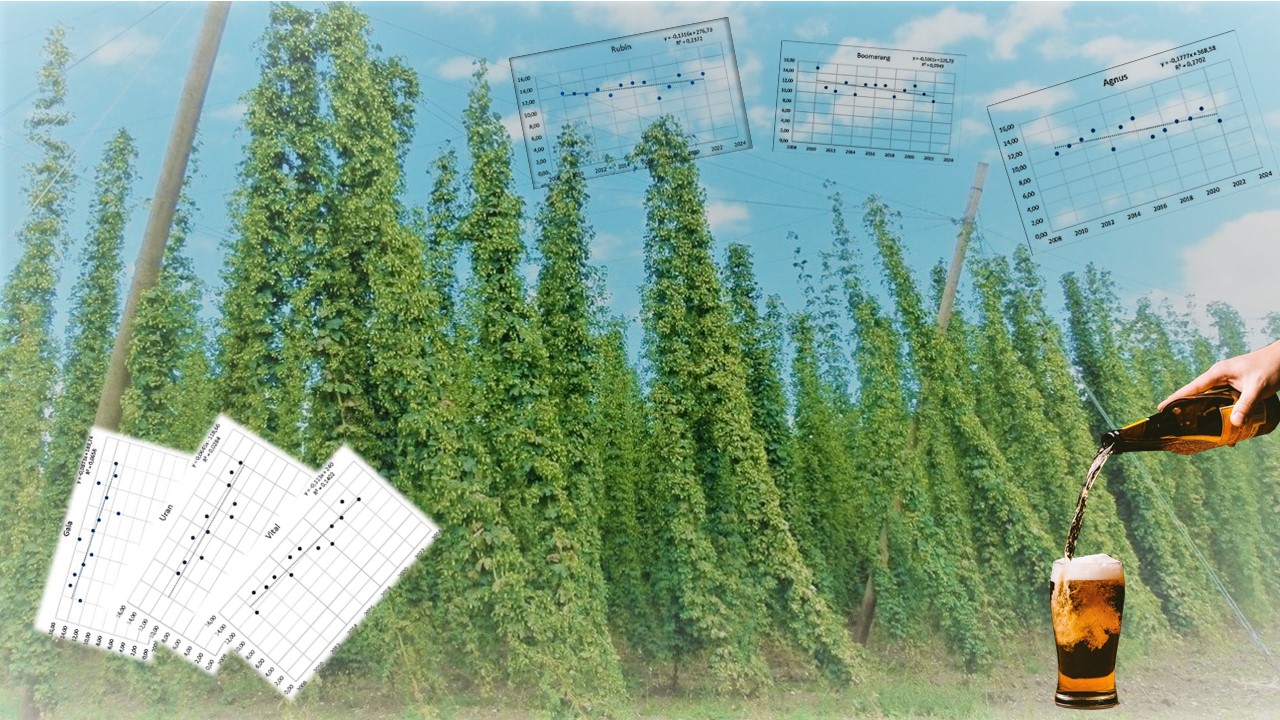Evaluation of variability of the content of alpha and beta acids in Czech bittering hop varieties (Humulus lupulus L.)
DOI:
https://doi.org/10.18832/kp2023.69.719Keywords:
hop, Humulus lupulus L., alpha acid content, beta acid content, variability, linear regressionAbstract
Czech bitter varieties were evaluated between 2010 and 2022. Hop varieties displayed an average content of alpha acids between 10.24% w/w (Agnus) and 13.73% w/w (Gaia). Variability below 15%, proved good stability of alpha acids content in all tested bittering hops. All varieties showed a decrease in the content of alpha acids over a period of 13 years of hop cultivation. The highest content of beta acids was determined in Gaia (7.30% w/w). In contrast, the lowest content of beta acids was found in Rubín (3.73% w/w). The new bitter genotypes Uran and 5304 had an average alpha acid content of 11.56% w/w and 10.82% w/w, respectively. Uran showed an average beta acid content of 5.47% w/w and for the genotype 5304 it was 3.61% w/w. In terms of the alpha/beta acids ratio, the hop varieties can be divided into three groups. The first group included the varieties with an alpha/beta acids ratio below 2, i.e. Vital, Boomerang and Gaia. While Agnus and Uran displayed an alpha/beta ratio slightly above 2. The highest alpha/beta ratio above 3 was found in Rubín and the 5303 genotype.
References
Basařová, G., Šavel, J., Basařová, P., Brož, A. (2021). Pivovarství - teorie a praxe výroby piva (Brewing - theory and practice of beer production) (2nd edition). Prague: Havlíček Brain Team. ISBN 978-80-87109-77-9
Haunold, A., Likens, S.T., Horner, C.E. (1976). Breeding for alfa acid production in hops. Scientific commission of the international hop growers convection 11.–14.8. 1976 England.
Harley, R.D., Neve, R.A. (1965). Chemical analysis and breeding value of male hops (Humulus lupulus L.), Journal of Horticultural Science, 43(2), 153–156. https://doi.org/10.1080/00221589.1968.11514242
Krajl, D. (1976). Jzbira ustrezne sorte je najvažnejši dejavnik za velike pridelke, Hmeljar,1976(1), 31–33.
Krofta, K., Nesvadba, V. (1999). Hodnocení hybridních odrůd a novošlechtění ze sklizně 1998, Chmelařství 1999(4): 52–55.
Krofta, K. (2008). Evaluation of hop quality: Methodology for practice 4/2008. Žatec: Hop Research Institute. Retrieved from https://invenio.nusl.cz/record/170477/files/nusl-170477_1.pdf
Krofta, K., Patzak, J., Nesvadba, V., Mikyška, A., Slabý, M., Čejka P. (2013). Vital – the Czech hop hybrid variety. Kvasný průmysl, 59(1), 13–17. https://doi.org/10.18832/kp2013019
Krofta, K., Fritschová, G., Mikyška, A., Belešová, K., Vojtěchová, D., Tichá, J. (2022). Alpha acids content in Czech hops from the harvest of 2021 - forecast, reality, trends. Kvasný průmysl, 68(1), 564–571. https://doi.org/10.18832/kp2022.68.564
Kršková, I., (2022). Aktuální plochy chmelnic v České republice. Chmelařství 5/2022: 62–63.
Meloun, M., Militký, J. (1994). Statistical processing of experimental data. Praha: Plus. ISBN 80-85297-56-6
Mori, Y. (1974). On same promising higt resin content hop selections bred by crossing, Bulletin of Brewing Science, 1974(14), 7–13.
Nesvadba, V., Krofta, K. (2002). New hop variety Agnus as the result of breeding process innovation in the Czech Republic. Rostlinná výroba, 48, 2002(11), 513–517.
Nesvadba, V., Charvátová, J., Vostřel V., Werschallová. M. (2020). Evaluation of Czech hop cultivars since 2010 till 2019. Plant, Soil and Environment, 66(12), 658–663.
Nesvadba, V., Olšovská. J., Straková. L., Charvátová., J. (2021). Evaluation of Czech hop varieties. Kvasný průmysl, 67(2), 428–434. https://doi.org/10.18832/kp2021.67.428
Nesvadba V, Charvátová, J., Trnková, S. (2022a). Evaluation of hop yield stability in Czech bitter hop varieties. Kvasny prumysl, 68(6), 674–678. https://doi.org/10.18832/kp2022.68.674
Nesvadba, V., Donner, P., Charvátová, J. (2022b). Hop breeding in the Czech Republic. In F. Weihrauch (Ed.), Scientific-Technical Commission of the International Hop Growers’ Convention (pp. 13–16). Lugo, Spain.
Nesvadba, V., Krofta, K., Patzak, J. (2022c). Atlas of Czech Hop Varieties, Žatec: Hop Research Institute. ISBN 978-80-86836-60-7, retrieved from http://www.chizatec.cz/atlas_chmele/cz/ChiZatec_Atlas_CZ.html
Schildbach, R. (1985). Über neue Hopfensorte, Hopfen Resch., 1985(8), 150–156.
Trefilová, M., Nesvadba, V., Charvátová, J. (2021). Evaluation of resistance to Pseudoperonospora humuli and of the content of alpha acids and hop oils in hops of selected genetic resources of hop Humulus lupulus L. Czech Journal of Genetics and Plant Breeding, 58(1), 36–42. https://doi.org/10.17221/70/2021-CJGPB
Verzele, M. (1979). The chemistry of hops. In J. R. A. Pollock (Ed.), Brewing Science Vol. 1 (pp. 280–319). London: Academic Press.

Downloads
Published
How to Cite
Issue
Section
License
Copyright (c) 2023 Vladimír Nesvadba, Lenka Straková, Gabriela Fritschová, Jana Olšovská, Jitka Charvátová, Sabina Trnková

This work is licensed under a Creative Commons Attribution 4.0 International License.







